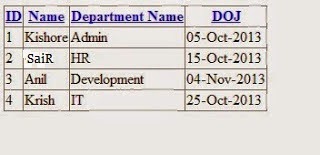Hi friends, in this article I will explain about Sorting GridView By Columns Header In Asp.Net Ascending and Descending in ASP.NET using C#/VB.NET.
I already explained in the previous articles Ajax ModalPopUpExtender Example to edit the GridView row values in ASP.NET, How to Bind Nested Gridview with expand collapse from Database in asp.net with C#/VB.NET and How to Export Gridview data to PDF File in ASP.NET using C#/VB.NET
I created Employee table in Database as shown in the below figure.
In ASP.NET:
I already explained in the previous articles Ajax ModalPopUpExtender Example to edit the GridView row values in ASP.NET, How to Bind Nested Gridview with expand collapse from Database in asp.net with C#/VB.NET and How to Export Gridview data to PDF File in ASP.NET using C#/VB.NET
I created Employee table in Database as shown in the below figure.
In ASP.NET:
<html xmlns="http://www.w3.org/1999/xhtml">
<head runat="server">
<title>Sorting GridView By Columns Header In Asp.Net Ascending and Descending in ASP.NET using C#/VB.NET</title>
</head>
<body>
<form id="form1" runat="server">
<div>
<asp:GridView runat="server" ID="grdSort" OnSorting="grdSort_Sorting" AutoGenerateColumns="false"
AllowSorting="true"
>
<Columns>
<asp:TemplateField HeaderText="ID"
SortExpression="Emp_ID">
<ItemTemplate>
<asp:Label ID="lblId"
runat="server"
Text='<%#Eval("Emp_ID")%>'/>
</ItemTemplate>
</asp:TemplateField>
<asp:TemplateField HeaderText="Name"
SortExpression="Name">
<ItemTemplate>
<asp:Label ID="lblname"
runat="server"
Text='<%#Eval("Name")%>'/>
</ItemTemplate>
</asp:TemplateField>
<asp:TemplateField HeaderText="Department
Name" SortExpression="DepartmentName">
<ItemTemplate>
<asp:Label ID="lblDName"
runat="server"
Text='<%#Eval("DepartmentName")%>'/>
</ItemTemplate>
</asp:TemplateField>
<asp:TemplateField HeaderText="DOJ"
SortExpression="DOJ">
<ItemTemplate>
<%--<asp:Label ID="lblDOJ"
runat="server" Text='<%#Eval("DOJ")%>'/>--%>
<%# string.IsNullOrEmpty(Convert.ToString(Eval("DOJ",
"{0:dd-MMM-yyyy}"))) ? "" : Eval("DOJ",
"{0:dd-MMM-yyyy}")%>
</ItemTemplate>
</asp:TemplateField>
</Columns>
</asp:GridView>
</div>
</form>
</body>
</html>
|
In C#.NET:
using System;
using
System.Collections.Generic;
using System.Linq;
using System.Web;
using System.Web.UI;
using
System.Web.UI.WebControls;
using System.Data;
using System.Data.SqlClient;
public partial class GridViewSort : System.Web.UI.Page
{
protected
void Page_Load(object
sender, EventArgs e)
{
if (!IsPostBack)
{
grdSort.DataSource
= BindData();
grdSort.DataBind();
}
}
protected
void grdSort_Sorting(object
sender, GridViewSortEventArgs e)
{
string sortingDirection = string.Empty;
if (sortDirection == SortDirection.Ascending)
{
sortDirection = SortDirection.Descending;
sortingDirection =
"Desc";
}
else
{
sortDirection = SortDirection.Ascending;
sortingDirection =
"Asc";
}
DataView sortedView = new
DataView(BindData());
sortedView.Sort =
e.SortExpression + " " +
sortingDirection;
grdSort.DataSource =
sortedView;
grdSort.DataBind();
}
protected
DataTable BindData()
{
DataTable ds = new
DataTable();
SqlConnection con = new
SqlConnection(System.Configuration.ConfigurationManager.ConnectionStrings["con"].ConnectionString);
SqlCommand cmd = new
SqlCommand("Select
* from Employee",con);
SqlDataAdapter da = new
SqlDataAdapter(cmd);
da.Fill(ds);
return ds;
}
public
SortDirection sortDirection
{
get
{
if (ViewState["Sort"]
== null)
{
ViewState["Sort"] = SortDirection.Ascending;
}
return (SortDirection)ViewState["Sort"];
}
set
{
ViewState["Sort"] = value;
}
}
}
|
In VB.NET:
Imports
System.Collections.Generic
Imports System.Linq
Imports System.Web
Imports System.Web.UI
Imports
System.Web.UI.WebControls
Imports System.Data
Imports System.Data.SqlClient
Partial Public Class GridViewSort
Inherits
System.Web.UI.Page
Protected
Sub Page_Load(ByVal
sender As Object,
ByVal e As EventArgs)
If Not IsPostBack Then
grdSort.DataSource
= BindData()
grdSort.DataBind()
End If
End
Sub
Protected
Sub grdSort_Sorting(ByVal
sender As Object,
ByVal e As GridViewSortEventArgs)
Dim sortingDirection As
String = String.Empty
If sortDirection = SortDirection.Ascending Then
sortDirection =
SortDirection.Descending
sortingDirection =
"Desc"
Else
sortDirection =
SortDirection.Ascending
sortingDirection =
"Asc"
End If
Dim sortedView As New DataView(BindData())
sortedView.Sort =
e.SortExpression & " " &
sortingDirection
grdSort.DataSource =
sortedView
grdSort.DataBind()
End
Sub
Protected
Function BindData() As
DataTable
Dim ds As New DataTable()
Dim con As New SqlConnection(System.Configuration.ConfigurationManager.ConnectionStrings("con").ConnectionString)
Dim cmd As New SqlCommand("Select * from Employee", con)
Dim da As New SqlDataAdapter(cmd)
da.Fill(ds)
Return ds
End
Function
Public
Property sortDirection() As SortDirection
Get
If ViewState("Sort")
Is Nothing Then
ViewState("Sort") = SortDirection.Ascending
End If
Return CType(ViewState("Sort"), SortDirection)
End Get
Set(ByVal value As SortDirection)
ViewState("Sort") = value
End Set
End
Property
End Class
|
The output of the above code as shown in the below figure.
When we sort on the ID column then it will shown in the descending order as shown in the below figure.



No comments:
Post a Comment